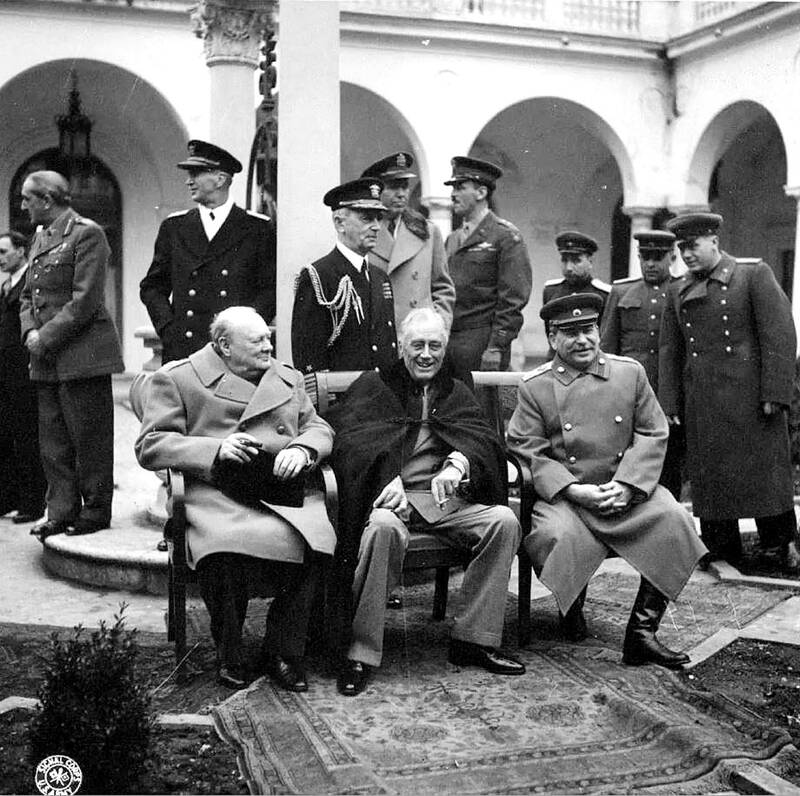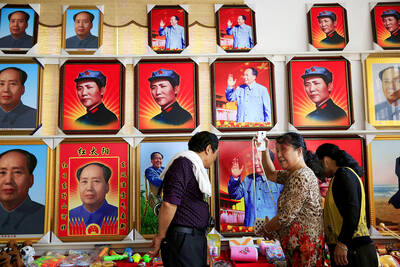Well, it turns out I finally did live long enough to see everything. Last week Reuters reported on a statement from the American Institute in Taiwan (AIT), America’s officially unofficial representative office in Taipei, that “China intentionally mischaracterises World War II-era documents, including the Cairo Declaration, the Potsdam Proclamation and the Treaty of San Francisco, to try to support its coercive campaign to subjugate Taiwan.”
Not only did Reuters forward this crushing rejection of the claims of the People’s Republic of China (PRC), it even correctly represented US policy on Taiwan’s status.
The director of the Ma Ying-jeou Foundation, Hsiao Hsu-tsen (蕭旭岑), then attacked AIT for its clear statement of US policy. Hsiao simply read out the KMT expansionist catechism on Taiwan, arguing that using the 1951 Treaty of San Francisco to claim that Taiwan’s status is unresolved is contrary to the constitution. He also said that Japan returned Taiwan to the Republic of China (ROC). He then went on to contend that the 1943 Cairo Declaration, the 1945 Potsdam Declaration and the Japanese Instrument of Surrender are legally binding documents in the eyes of international law. The legal effect of the documents have never been questioned by the parties named in them, he said.

Photo courtesy of the Franklin D. Roosevelt Presidential Library and Museum
Every claim in there is wrong, of course. The torching of KMT imperialist claims to Taiwan was completed on Sept. 16, when the pro-KMT United Daily News (UDN) reported that the US State Department had confirmed AIT’s characterization of the US position. As the State Department’s comments showed, many of the parties named in Cairo, Potsdam and the Japanese Instrument of Surrender do not take the position that they are legally binding determinations of the status of Taiwan under international law.
Contrary to Hsiao’s assertions, standard claims made by Chinese expansionists on both sides of the Taiwan Strait, the Cairo Declaration and Potsdam Proclamation are simply declarations of policy by the allies and have no binding effect on Taiwan’s status under international law. Cairo and Potsdam were subject to change as conditions change, as President Harry Truman observed in his statement of June 27, 1950. Truman observed that “the determination of the future status of Formosa [Taiwan] must await the restoration of security in the Pacific, a peace settlement with Japan or consideration by the United Nations.”
This position was reiterated in Truman’s statement of Dec. 27, 1950.
Moreover, the KMT government of the ROC knows this perfectly well. For example, after the Treaty of Taipei was signed, Foreign Minister Yeh Kung-chao (葉公超), questioned in the legislature, averred that “no provision has been made either in the San Francisco Treaty of Peace as to the future of Taiwan and Penghu.”
Internal documents of Taiwan’s Ministry of Foreign Affairs (for example, see the May 13, 1952, “Report on the Signing of the Peace Treaty between ROC and Japan,” Vol. 54, page 11) and Chiang Kai-shek’s (蔣介石) letters also confirm this. I will leave it to the reader to decide whether PRC and KMT spokespersons are ignorant of this history, or simply lying.
Recall too that in 1950, when Truman was discussing the disposition of Taiwan, it was owned by Japan, and that the Taiwanese themselves were not consulted about their future. Even if one accepts Cairo as legally binding, by the internationally-agreed rules of the 1940s, Taiwan could not change hands without the consent of its people, as Chen Lung-chu (陳隆志) and W. M. Reisman note in their classic 1972 Yale Law Review piece, “Who Owns Taiwan?”: “Jure gentium, the Cairo Declaration could mean only that the participants agreed to recognize a Chinese acquisition of Formosa if the inhabitants of Formosa indicated that they desired to be part of or to be governed by China.”
Similarly, the Japanese Instrument of Surrender only lays out the terms of surrender to Japan. It binds the Allied powers to nothing. Again, it must be noted that the ROC occupied Taiwan on behalf of the Allies, not because Taiwan was “returned.” Instead, Japan retained sovereignty over Taiwan until April 28, 1952, when the San Francisco Peace Treaty came into effect.
Hsiao’s statement that the ROC Constitution makes Taiwan part of the ROC is an especially beloved claim of KMT apologists for Chinese imperialism. It too is false. In 1993, a group from the Democratic Progressive Party (DPP) led by Chen Wan-chen (陳婉真) asked the Council of Grand Justices (now the Constitutional Court) to determine whether Mongolia and “mainland China” were territories under the ROC Constitution. In ruling #328 issued Nov. 26, 1993, the justices stated that the scope of the nation’s territory is a matter for political determination, and should not be left to the judiciary to define. As one longtime Taiwan observer put it in a private communication, the ruling made it impossible to legally violate Article 4.
Moreover, Article 4 was superseded in 2005 by an amendment to Additional Article 1, stating that “The provisions of Article 4 and Article 174 of the Constitution shall not apply.” That amendment also subjects changes in the national territory to a referendum of the population. This means that the hoary idea of “fixed national territory” (固有之疆域) is now just another lump of twisted metal on the scrapheap of history. The territory of the ROC is thus not defined in its constitution.
An additional though minor problem with the claim that Japan “returned” Taiwan to “China” is the lack of a signed document confirming the transfer of sovereignty. While the April 17, 1895 Treaty of Shimonoseki mandated that Taiwan be transferred to Japanese rule, the document formally confirming the transfer of sovereignty was signed by representatives of the Manchu (Qing) and Japanese empires on June 2, 1895. No such document exists for the “return” of Taiwan, because it has never been “returned.”
It’s a rare joy to see the US push back forcefully against Chinese expansionist propaganda, something I’ve been advocating for years. Sustained, repeated pushback by US officials against PRC narratives would have a powerful effect on the local and international discourse on the status of Taiwan.
More importantly, the US needs to take on the entire framework of faux history that the PRC has created to justify its imperialism. The US needs to talk about how the PRC is “annexing” Taiwan illegally under international law. Whenever the PRC says annexation is inevitable, the US should ask why that never happened in history, emphasizing that Taiwan has never been part of a Chinese empire. The US should also center the people of Taiwan in its discussions of Taiwan’s status: when were they ever given the choice mandated in the UN documents on decolonization, agreements that the PRC has signed? Not only would this help the people of Taiwan, it would provide a clear, easily-grasped moral and political framework for US intervention when the PRC finally moves on Taiwan.
Notes from Central Taiwan is a column written by long-term resident Michael Turton, who provides incisive commentary informed by three decades of living in and writing about his adoptive country. The views expressed here are his own.

Taiwan can often feel woefully behind on global trends, from fashion to food, and influences can sometimes feel like the last on the metaphorical bandwagon. In the West, suddenly every burger is being smashed and honey has become “hot” and we’re all drinking orange wine. But it took a good while for a smash burger in Taipei to come across my radar. For the uninitiated, a smash burger is, well, a normal burger patty but smashed flat. Originally, I didn’t understand. Surely the best part of a burger is the thick patty with all the juiciness of the beef, the

The ultimate goal of the Chinese Communist Party (CCP) is the total and overwhelming domination of everything within the sphere of what it considers China and deems as theirs. All decision-making by the CCP must be understood through that lens. Any decision made is to entrench — or ideally expand that power. They are fiercely hostile to anything that weakens or compromises their control of “China.” By design, they will stop at nothing to ensure that there is no distinction between the CCP and the Chinese nation, people, culture, civilization, religion, economy, property, military or government — they are all subsidiary

This year’s Miss Universe in Thailand has been marred by ugly drama, with allegations of an insult to a beauty queen’s intellect, a walkout by pageant contestants and a tearful tantrum by the host. More than 120 women from across the world have gathered in Thailand, vying to be crowned Miss Universe in a contest considered one of the “big four” of global beauty pageants. But the runup has been dominated by the off-stage antics of the coiffed contestants and their Thai hosts, escalating into a feminist firestorm drawing the attention of Mexico’s president. On Tuesday, Mexican delegate Fatima Bosch staged a

Nov.10 to Nov.16 As he moved a large stone that had fallen from a truck near his field, 65-year-old Lin Yuan (林淵) felt a sudden urge. He fetched his tools and began to carve. The recently retired farmer had been feeling restless after a lifetime of hard labor in Yuchi Township (魚池), Nantou County. His first piece, Stone Fairy Maiden (石仙姑), completed in 1977, was reportedly a representation of his late wife. This version of how Lin began his late-life art career is recorded in Nantou County historian Teng Hsiang-yang’s (鄧相揚) 2009 biography of him. His expressive work eventually caught the attention